ASRock Z87M OC Formula Review: mATX OC at $190
by Ian Cutress on August 14, 2013 10:00 AM EST- Posted in
- Motherboards
- ASRock
- Haswell
- Z87
Computation Benchmarks
Readers of our motherboard review section will have noted the trend in modern motherboards to implement a form of MultiCore Enhancement / Acceleration / Turbo (read our report here) on their motherboards. This does several things – better benchmark results at stock settings (not entirely needed if overclocking is an end-user goal), at the expense of heat and temperature, but also gives in essence an automatic overclock which may be against what the user wants. Our testing methodology is ‘out-of-the-box’, with the latest public BIOS installed and XMP enabled, and thus subject to the whims of this feature. It is ultimately up to the motherboard manufacturer to take this risk – and manufacturers taking risks in the setup is something they do on every product (think C-state settings, USB priority, DPC Latency / monitoring priority, memory subtimings at JEDEC). Processor speed change is part of that risk which is clearly visible, and ultimately if no overclocking is planned, some motherboards will affect how fast that shiny new processor goes and can be an important factor in the purchase.
For the media BIOS shipped with the motherboard (1.11), MCT was enabled, but as of the latest public BIOS used in this review (1.30), it was disabled by default. ASRock asked for our opinion on this, and the answer was simple – MCT should be enabled for all Extreme and OC motherboards, disabled for the rest. So there might be a case of a later BIOS enabling MCT by default.
Update 2013.08.13: ASRock have confirmed that the Z87M OC Formula, from BIOS 1.50, will have MCT enabled by default.
Point Calculations - 3D Movement Algorithm Test
The algorithms in 3DPM employ both uniform random number generation or normal distribution random number generation, and vary in various amounts of trigonometric operations, conditional statements, generation and rejection, fused operations, etc. The benchmark runs through six algorithms for a specified number of particles and steps, and calculates the speed of each algorithm, then sums them all for a final score. This is an example of a real world situation that a computational scientist may find themselves in, rather than a pure synthetic benchmark. The benchmark is also parallel between particles simulated, and we test the single thread performance as well as the multi-threaded performance.
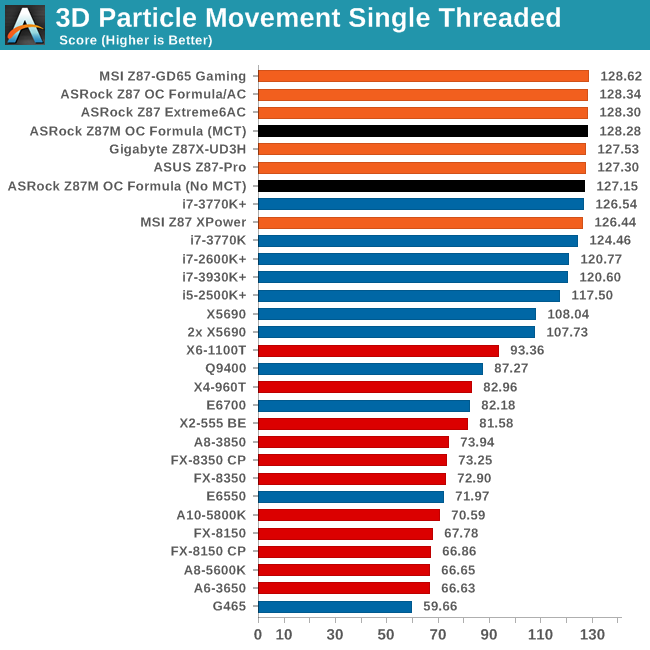
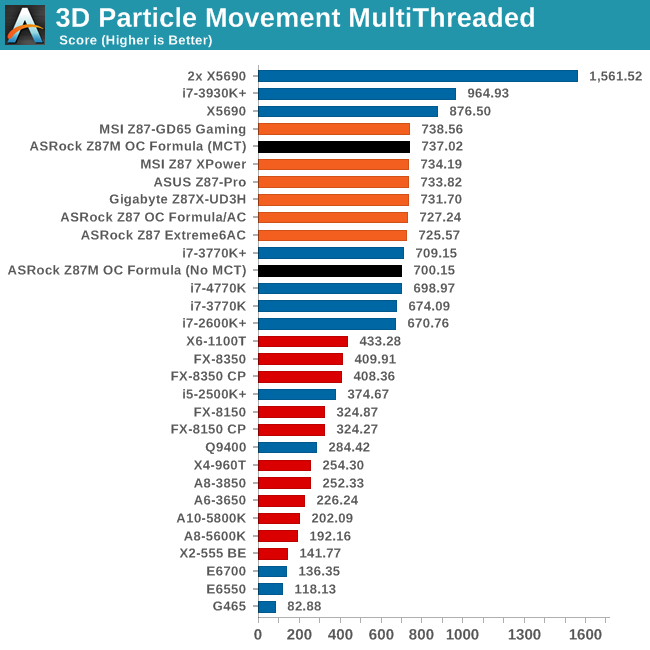
MCT makes a small difference in single threaded mode, as there is no determination in the CPU for what speed needs to be used. However it is obvious in the multithreaded test that having those extra MHz makes a difference.
Compression - WinRAR 4.2
With 64-bit WinRAR, we compress the set of files used in the USB speed tests. WinRAR x64 3.93 attempts to use multithreading when possible, and provides as a good test for when a system has variable threaded load. WinRAR 4.2 does this a lot better! If a system has multiple speeds to invoke at different loading, the switching between those speeds will determine how well the system will do.

Internal numbers show that for WinRAR 3.93, MCT does not make much of a difference (<1%), but for the later versions that use multiple threads more efficiently, there is a small reminder of how much extra CPU power can matter.
Image Manipulation - FastStone Image Viewer 4.2
FastStone Image Viewer is a free piece of software I have been using for quite a few years now. It allows quick viewing of flat images, as well as resizing, changing color depth, adding simple text or simple filters. It also has a bulk image conversion tool, which we use here. The software currently operates only in single-thread mode, which should change in later versions of the software. For this test, we convert a series of 170 files, of various resolutions, dimensions and types (of a total size of 163MB), all to the .gif format of 640x480 dimensions.

Video Conversion - Xilisoft Video Converter 7
With XVC, users can convert any type of normal video to any compatible format for smartphones, tablets and other devices. By default, it uses all available threads on the system, and in the presence of appropriate graphics cards, can utilize CUDA for NVIDIA GPUs as well as AMD WinAPP for AMD GPUs. For this test, we use a set of 33 HD videos, each lasting 30 seconds, and convert them from 1080p to an iPod H.264 video format using just the CPU. The time taken to convert these videos gives us our result.
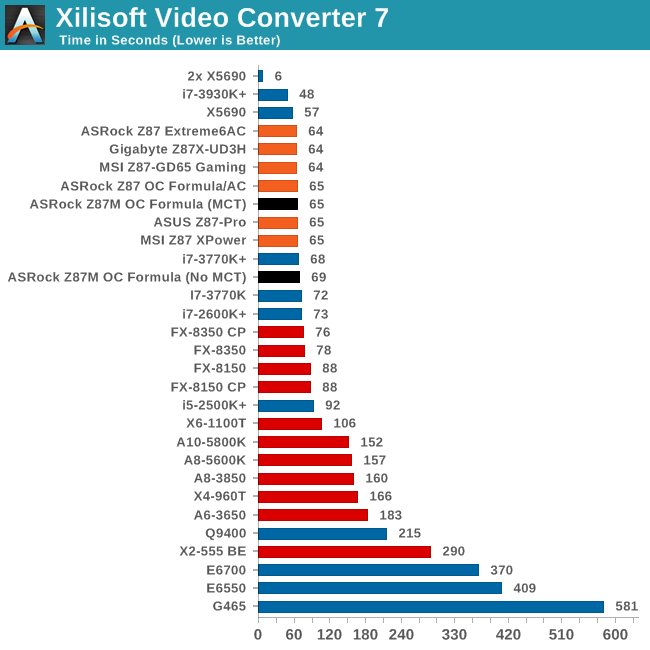
With full multithreading, having MCT enabled at stock shaves off a few seconds.
Rendering – PovRay 3.7
The Persistence of Vision RayTracer, or PovRay, is a freeware package for as the name suggests, ray tracing. It is a pure renderer, rather than modeling software, but the latest beta version contains a handy benchmark for stressing all processing threads on a platform. We have been using this test in motherboard reviews to test memory stability at various CPU speeds to good effect – if it passes the test, the IMC in the CPU is stable for a given CPU speed. As a CPU test, it runs for approximately 2-3 minutes on high end platforms.
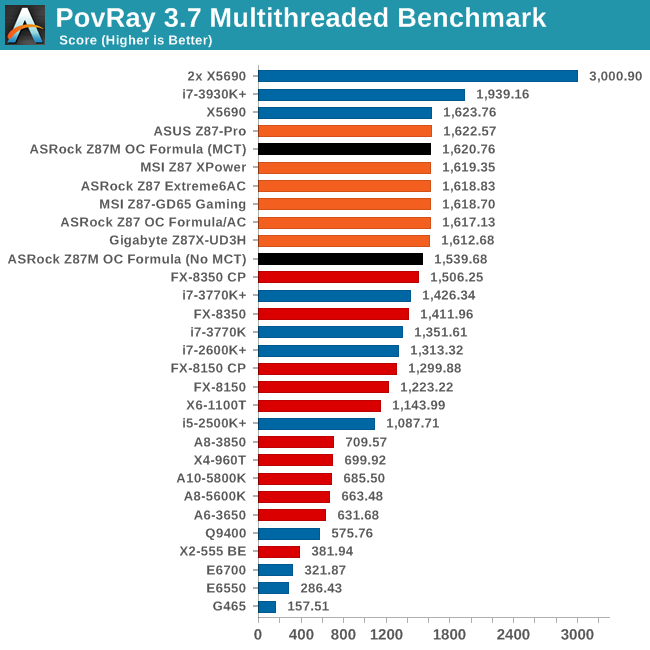
With MCT enabled, the M-OCF is near the top, but without it falls behind a significant margin.
Video Conversion - x264 HD Benchmark
The x264 HD Benchmark uses a common HD encoding tool to process an HD MPEG2 source at 1280x720 at 3963 Kbps. This test represents a standardized result which can be compared across other reviews, and is dependent on both CPU power and memory speed. The benchmark performs a 2-pass encode, and the results shown are the average of each pass performed four times.
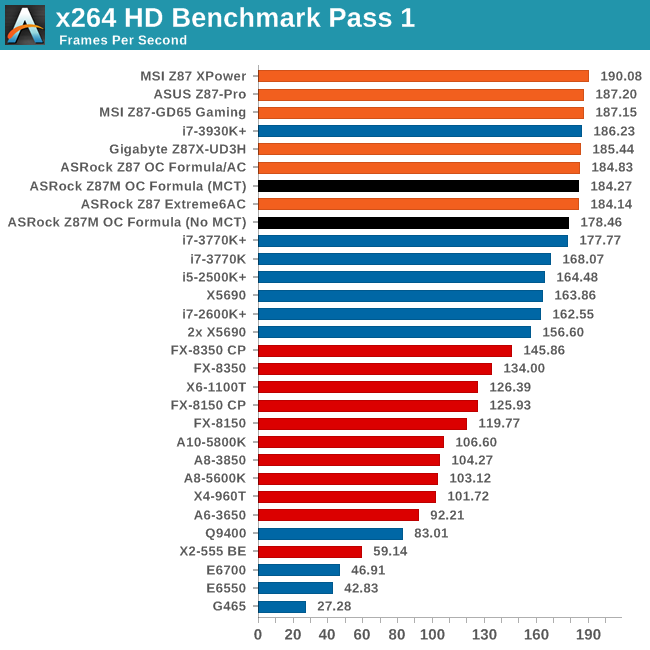
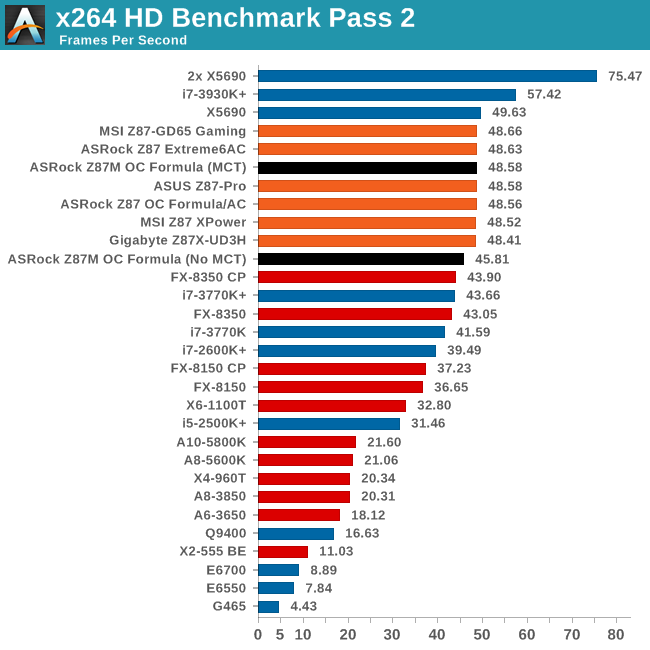
Grid Solvers - Explicit Finite Difference
For any grid of regular nodes, the simplest way to calculate the next time step is to use the values of those around it. This makes for easy mathematics and parallel simulation, as each node calculated is only dependent on the previous time step, not the nodes around it on the current calculated time step. By choosing a regular grid, we reduce the levels of memory access required for irregular grids. We test both 2D and 3D explicit finite difference simulations with 2n nodes in each dimension, using OpenMP as the threading operator in single precision. The grid is isotropic and the boundary conditions are sinks. Values are floating point, with memory cache sizes and speeds playing a part in the overall score.
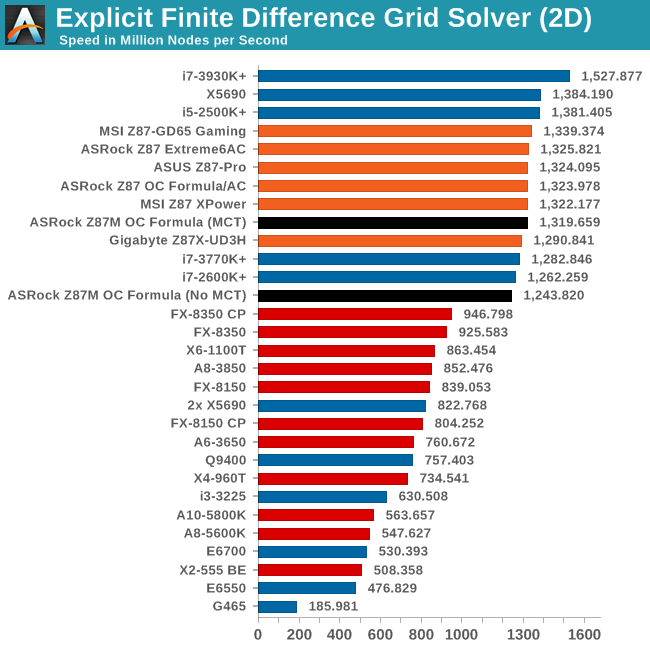
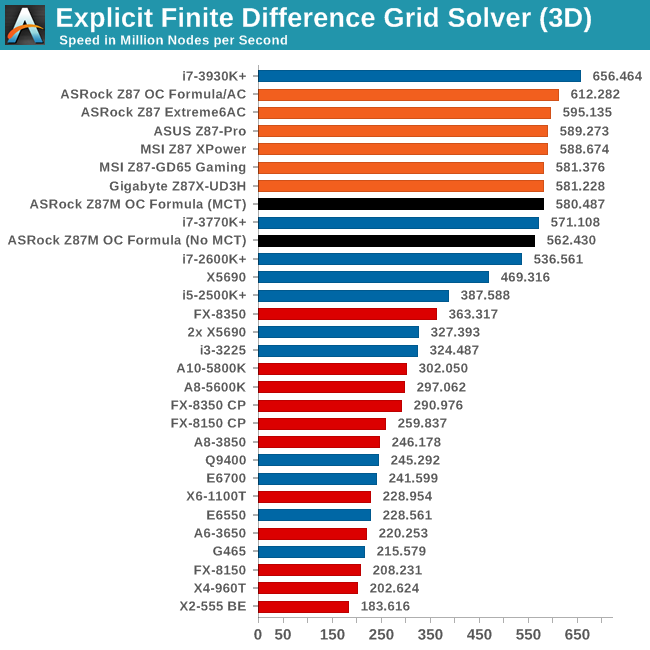
Unlike the ATX Z87 OCF, the MOCF does not seem to have that push in 3D, being some 5% behind.
Grid Solvers - Implicit Finite Difference + Alternating Direction Implicit Method
The implicit method takes a different approach to the explicit method – instead of considering one unknown in the new time step to be calculated from known elements in the previous time step, we consider that an old point can influence several new points by way of simultaneous equations. This adds to the complexity of the simulation – the grid of nodes is solved as a series of rows and columns rather than points, reducing the parallel nature of the simulation by a dimension and drastically increasing the memory requirements of each thread. The upside, as noted above, is the less stringent stability rules related to time steps and grid spacing. For this we simulate a 2D grid of 2n nodes in each dimension, using OpenMP in single precision. Again our grid is isotropic with the boundaries acting as sinks. Values are floating point, with memory cache sizes and speeds playing a part in the overall score.
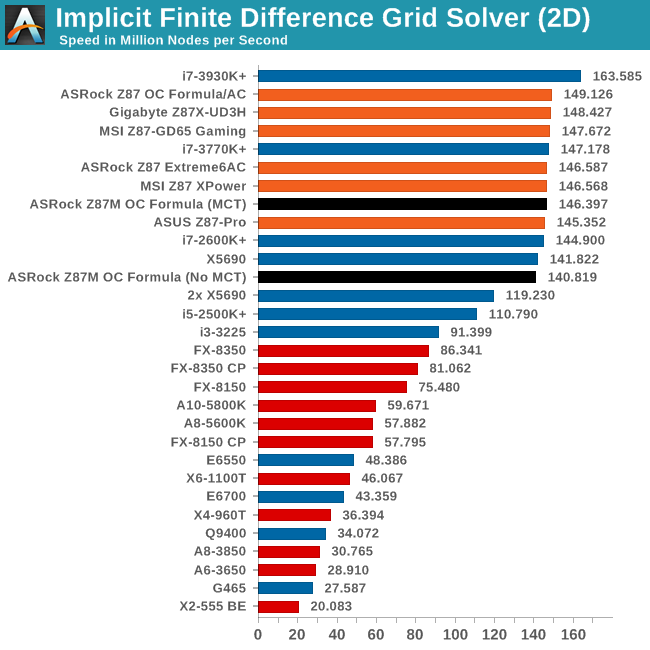
Point Calculations - n-Body Simulation
When a series of heavy mass elements are in space, they interact with each other through the force of gravity. Thus when a star cluster forms, the interaction of every large mass with every other large mass defines the speed at which these elements approach each other. When dealing with millions and billions of stars on such a large scale, the movement of each of these stars can be simulated through the physical theorems that describe the interactions. The benchmark detects whether the processor is SSE2 or SSE4 capable, and implements the relative code. We run a simulation of 10240 particles of equal mass - the output for this code is in terms of GFLOPs, and the result recorded was the peak GFLOPs value.











25 Comments
View All Comments
Pessimism - Wednesday, August 14, 2013 - link
Who overclocks anymore? Better off to just save your money and buy the next CPU up IMO.Horza - Wednesday, August 14, 2013 - link
So if I buy a 4770k and overclock it to 4.5hgz (kind of the point with the K series) what's your advice?Overclocking is an easy way to get some free performance and can be a bit of fun at the same time.
Pessimism - Wednesday, August 14, 2013 - link
Since you're already at the top end for desktop parts, my advice would depend on what task you perform that saturated the 4770K at stock speeds.RealiBrad - Wednesday, August 14, 2013 - link
So if I'm a gamer, its better for me to buy an I7 over an I5, even though I can get an I5 and OC it past the base performance of any I7.Why?
Pessimism - Wednesday, August 14, 2013 - link
You will spend more on the rest of the computer to do it than if you had bought the i7 in the first place. You will also spend more on electricity to power your PC. Yes you will gain a little CPU capacity over a stock i7, I can't deny that. However you haven't provided any example of an everyday gaming or computing scenario that saturates an i7 and justifies all the extra expense, energy consumption and hassle. Don't get me wrong, I was clocking the snot out of a 2500 Barton back in the day like everyone else, I just think the cost/benefit ratio isn't there anymore when you look at how far hardware is past software right now.karasaj - Wednesday, August 14, 2013 - link
Starcraft II. I can bring my 4.6ghz 4670k to its knees in real world scenarios if I want too. That wasn't hard :Pkarasaj - Wednesday, August 14, 2013 - link
Real world scenarios being team games and intense 1v1's.owan - Wednesday, August 14, 2013 - link
"All the extra expense"... how much do you think it costs? With an unlocked multiplier on the CPU's, its quite easy to overclock and doesn't incur much added expense. Any halfway decent motherboard that has the features you want on it is going to be fully capable of overclocking quite a bit anyway. The electricity difference is going to still be there, but is probably fairly small.. Maybe 20-30W ? With TDP's on the Intel chips these days, it really doesn't take a big cooler to cool them, even if overclocked. A CM Hyper 212+ can be bought for something like $20 and does the job really well. Lots of people would be buying an HSF capable of handling the additional heat anyway. You could easily build a rig capable of overclocking for less than it would cost to jump to a high-end i7 and get equal or better performance.RealiBrad - Wednesday, August 14, 2013 - link
So if I'm building a new system, and the game I'm likely to play will have a cpu bottleneck with an i5-4670, its cheaper for me to spend more on upgrading to a locked i7-4770 for $90 more and get a few frames increase at best? Why would it not be better to take that same $90 and get a i5-4670k and a mobo that can adjust the multiplier? If an i5 is bottlenecked then getting any locked i7 will do nothing. Its far better to get an unlocked i5 and OC it to reduce the bottle neck. yes, the mobo will cost a little more, but the jump from an i5 to an i7 is still more expensive than getting a i5 k and mobo.IanCutress - Wednesday, August 14, 2013 - link
It depends what you do. If you overclock and get another 25% performance, that enables you to complete 5 tasks in the same time as 4. If the reward for doing that task is more than the cost of the electricity, then it's a no brainer. This is particularly relevant in the financial industries, where every millisecond counts, or for careers that are throughput limited.That's just for workloads - gamers are often not worried about the cost of electricity when it comes to pure performance, and overclocking to increase single core performance, particularly in games like Civilization V that respond well to overclocking (http://www.anandtech.com/show/6985/choosing-a-gami... result in a rise of FPS.
There is also the aspect of competitive overclockers, who see it as a challenge to out-overclock their competitors. As mentioned in the review, this is one of the target groups for OC-oriented motherboards, and the motherboard needs to have features to appeal to this crowd.
Just because you do not overclock anymore does not mean that the activity is dead/no longer useful. It is alive and kicking - the amount of pre-overclocked systems on sale today is just one prong of this.
Ian